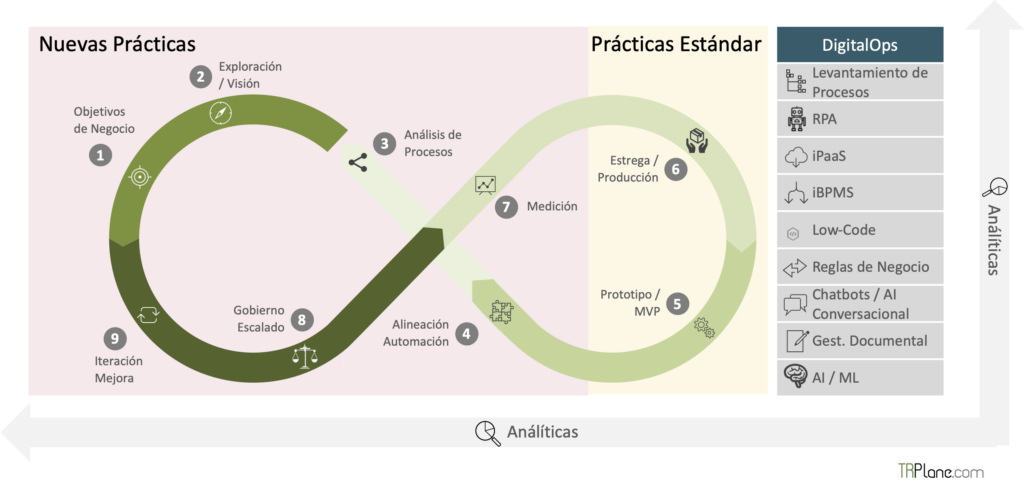Inteligencia Artificial
La incertidumbre económica y operativa causada por la pandemia de COVID-19 ha obligado a muchas empresas a centrarse en éxito rápidos de automatización. Parece que la mayoría de esas éxitos han venido de la automatización de tareas (RPA) sin un enfoque en el plano general y los procesos comerciales de los que forman parte.
Esto probablemente creará una deuda técnica y de procesos a largo plazo para las organizaciones. Para paliar este escenario se plantea un nuevo enfoque que es el de la Hiperautomatización.
Los retos iniciales son los siquientes:
- Cómo escalar más allá de RPA y alcanzar dicha hiperautomatización
- La matriz de alineación de automatización para la hiperautomatización
- Hoja de ruta de la hiperautomatización
Definición de hiperautomatización
Empezando por el principio, la hiperautomatización impulsada por el negocio se refiere a un enfoque en el que las organizaciones identifican, examinan y automatizan rápidamente tantos procesos comerciales y de tecnología aprobados a través de un enfoque disciplinado.
La hiperautomatización, impulsada por el negocio, implica el uso orquestado de múltiples tecnologías, herramientas o plataformas.
Un modelo para afrontar el proceso de hiperautomatización encajaría con el siguiente esquema.

Paso 1
El primer paso consiste en definir los objetivos comerciales. ¿Cual será el resultado? ¿Qué necesita cambiar? ¿Se persigue el crecimiento y los ingresos deben aumentar? ¿Aumento de rentabilidad? ¿Se reducen los costes? ¿Hay que aplicar una política de cumplimiento?
Por ejemplo, para Wells Fargo, el cumplimiento, regulación y legal han sido unos de sus principales impulsores. Requieren dirigirse hacia la reducción del riesgo y asegurarse de que se cumplan con las regulaciones gubernamentales.
Cuando se empieza con el objetivo comercial, se impulsa lo que acaba siendo la ambición digital. Esto asegura la focalización en temas clave. Siempre se trata de los objetivos y la tecnología como apoyo y ayuda.
Paso 2
Una vez fijados los objetivos comerciales, se establece una visión global de necesidades sobre los programas y procesos existentes. La mayor parte de las mejoras y cambios serán la automatización, dado que muchos trabajos tienen elementos sustanciales que pueden automatizarse.
Según WorkMarket, el 53 por ciento de los empleados creen que podrían ahorrar hasta 20 horas al mes automatizando tareas (Informe WorkMarket 2020 In (Sight)).
Restringirse a la automatización es una visión parcial que requiere ampliarse vy para ello pueden emplearse prácticas como Design Thinking o Game Theory para llevar a la empresa a través de escenarios hipotéticos. Puede ocurrir que se derive una visión de derribar por completo lo que actualmente existe y automatizar todo el proceso desde cero, o mejorar iterativamente lo que tiene al automatizar de forma parcial el proceso.
Esta conclusión es bastante usual ya que la mayoría de los procesos están diseñados para otros momentos tecnológicos, comercial, o no contemplan los nuevos hábitos digitales del mercado y los clientes.
Paso 3
Con objetivos comerciales y la visión, debe realizar el proceso de documentar detalladamente el trabajo a realizar. Un análisis previo de los procesos ayuda a alinear los resultados de los procesos con los objetivos comerciales.
Afortunadamente, este trabajo ya no es tan difícil como solía ser. Las herramientas de minería de datos y detección de procesos automatizados han evolucionado notablemente para ello.
Aún así, la tecnología es un medio, no el fin. Se necesitan expertos en la materia que trabajen con analistas de procesos para llevar sus modelos al extremo.
Las herramientas de detección y minería de procesos automatizadas tienen limitaciones inherentes que aún requieren la intervención humana y el análisis para brindarle la información necesaria para diseñar sus procesos de manera que se alineen con sus ambiciones digitales.
En particular, las herramientas de minería de procesos adjuntas a las herramientas de RPA casi siempre acaban derivando hacia RPA. Si tienes un martillo, todo parece un clavo.
También hay que considerar que es el momento de realizar simulaciones de escenarios para ver qué resultados aparecen a medida que se realizan cambios en los procesos. ¿Qué sucede si en lugar de clasificar manualmente las facturas, un motor de ingestión de documentos que lo hace? ¿Qué sucede si hay bots que se hacen cargo de cierto trabajo rutinario?
Paso 4
Una vez disponible una definicón extensa y ambiciosa del trabajo a realizar, se realiza un análisis de soluciones tecnológicas para determinar cual es la más adecuada para el tipo de resultado esperado.
Este análisis, que es más visual si se presenta en modo matriz es necesario ya suelen apareceer tenían dificultades para determinar cuándo usar cuál de las muchas herramientas de automatización disponibles.
El conjunto de herramientas DigitalOps es una base completa de los componentes que deben aparecer en la matriz. La alineación de la automatización es un paso muy importante que garantiza que se evite el problema de que se mencionó en el Punto 3 de acabaar derivando todo a soluciones de sólo RPA.
Este análisis es un paso vital para asegurar de que está utilizando la herramienta de automatización correcta en el momento y lugar correctos en los procesos. Se podría argumentar que pertenece al paso de Análisis de procesos (Paso 2), pero tiene la suficiente relavancia y complejidad, teniendo en cuenta las infraestructuras disponibles en cada organización, para tener su propio «paso».
Pasos 5 y 6
Una vez que se hanrealizado las tareas preliminares y se ha plasmado, al menos en lo que respecta a RPA y la implementación de bots, primeros prototipos o la creación de productos mínimos viables para determinar los ajustes de forma más eficaz y eficiente.
Este paso, ya está muy implantado y es una buena practica en toda la industria. Lo mismo ocurre con laentrega y el pase a producción, al menos para las implementaciones iniciales. Donde hay desafíos es poder escalar más allá de prototipos, pilotos e implementaciones de producción limitadas.
Paso 7
Todos los pasos expuestos, realizados de forma ordenada, son clave. Sin embargo, la monitorización y la medición son claves para poder establecer el plan de escalabilidad y hacer crecer los esfuerzos hacia la Hiperautomatización.
La monitorización es beneficiosa para ayudar a llegar al resultado. Sin embargo, es poco útil si no se conoce desde dónde se parte, dónde se encuentra en este momento.
Es un mapa que no puede dar instrucciones o establecer predicciones futors si no conoce el contexto.
En el proceso de automatización, nada de eso es posible sin un modelo eficaz de Analítica de Datos.
La información comercial no es un buen indicador por sí sola. La situación real y su seguimiento, también debe poder medir el rendimiento de la solución, gestión del cambio, ind¡cidencias, costes, etcétera. Con esa información se puede predecir lo que sucederá.
Esencialmente, todos estos datos deben informar y pronosticar si los resultados de su proceso lo ayudarán o impedirán alcanzar los objetivos comerciales definidos en el Paso 1. Esto es realmente lo que importa. Si no se están obteniendo los resultados del proceso adecuados, hay averiguar cómo realizar el cambio apropiado para lograr el resultado deseado. El resto de las métricas de rendimiento son interesantes pero no determinantes.
Paso 8
A medida que empiecen a aparecer los primeros resultados de éxito, se requiere un gobierno y el plan de escalado.
El reto consiste en que, llegados a este punto, se disponen de muchas disciplinas necesarias para la variedad de herramientas disponibles en DigitalOps, así como disciplinas menos técnicas, pero no menos críticas, como el análisis de procesos o la reingeniería.
Además, a medida que se produce el escalado, también se estarán incorporando nuevos esfuerzos de automatización.
Las metodologías y el COE (Computer-Optimized Equalization, prácticas para equilibrio entre los elementos tecnológicos) deben tener todo este escenario en consideracion.
Intentar escalar los procesos de automatización sin un gobierno que establezca metodologías y busque el equilibrio tecnológico produce duplicación de esfuerzos, silos y desorden. En otras palabras, es posible que se esté automatizando, pero el enfoque será muy ineficiente en toda la empresa y, por lo tanto, tendrá un alto coste de oportunidad frente a los competidores.
Paso 9
La iteración, revisión y mejoracontinua es vital, y parte integral para impulsar el negocio.
Esto suele plantear la pregunta de cuando dejar de gastar dinero en la mejora de procesos. La respuesta tiene que ser clara: cuando el proceso se considera tan bueno que ya no se necesita preocuparse por la competencia, entonces se puedes dejar de mejora. Esto genera una siguiente pregunta que todos en la organización deben hacerse es si se ha llegado a nivel muy por encima del resto o, más ambicioso, si realmente alguna vez se puede considerar ese nivel de optimización.
Por otro lado, basar esta decisión estrictamente en la competencia es una simplificación excesiva. También está la consideración de los objetivos comerciales, los recursos que no son infinitos, la satisfacción del cliente, tendencias, … todos estos factores obligan a hacer una selección de ciertos procesos en los que hay que comprometerse en mejorar continuamente.
La Hiperautomatización se describe como un bucle infinito.
Conclusiones
Con frecuencia en la automatización los éxitos iniciales son las implementaciones básicas de RPA. Esto genera mucho entusiasmo general, pero posteriormente se realentiza en cómo escalar y hacer crecer estos éxitos parciales hasta la Hiperautomatización.
Los impulsores más importantes del éxito final, una vez que superada esa fase de euforia iniciall, son los dos tercios izquierdos del esquema del bucle infinito que aparece en el esquema de esta publicación.
En ese momento se manifiesta la poca experiencia en Hiperautomatización. Los pasos uno al cuatro, y del siete al nueve, son donde entra en juego la parte ordenada, planificada e iterativa del ciclo infinito. Estos pasos son donde está el trabajo pesado. Son la parte disciplinaria de Hiperautomatización.
Sin embargo, también tienen la recompensa más significativa por sus esfuerzos. La mejor manera de distanciarse de la competencia es vincular los resultados del proceso con los objetivos comerciales y ajustarlos en función de esos resultados. Para lograr esto, debe adoptarse un enfoque holístico de la automatización, y no sólo centrarse en un tercio del bucle infinito de hiperautomatización.
En resumen, la hiperautomatización es un enfoque impulsado por el negocio, iterativo y disciplinado, que permite acelerar los esfuerzos y resultados de automatización.
No se puede lograr la Hiperautomatización sólo con RPA. El conjunto de DigitalOps es clave para poder tener las herramientas necesarias para escalar. Si bien los esfuerzos de automatización suelen tener éxito en las implementaciones piloto iniciales y en pequeños departamentos, las organizaciones requieren escalar más allá de los éxitos iniciales. Llegar a la hiperautomatización requiere un enfoque más riguroso para definir sus objetivos comerciales por adelantado y dejar que estos impulsen las decisiones digitales que toma a medida que desarrolla el programa de automatización.

